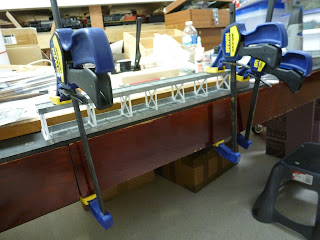Well, I spent Memorial weekend gathering material and then practicing how to hang that photo mural you saw earlier. Dave at Backdrop Junction was kind enough to work with me and sent me a practice sheet to fool with. I cut the sky off the mural and taped it up to see how it would look.
I was quite impressed as the blue of the sky on the backdrop integrated nicely with blue on the wall. The trees fairly jumped out at you when they contrasted with the wall. I thought it looked really good so that cemented my approach to hanging the mural.
Here you can see how nice it looks and how the seam between the photo and the wall disappears when it is on the tree line. You can see a little difference in the blue behind the tree at the far left but I think that will disappear when the whole scene is finished.
So, I set up two tables to lay out the mural sections which are about 7 feet long. I then used a cutting board and a very sharp knife to cut the boarder.
I tried to cut the border at an edge to hide the white of the vinyl at the cut line. I then had to trim the vertical edge to match the previous sheet.
I cut notches into the white lower border so I could line up the photo with a string line that I would put on the wall on my horizon line which was about 2 inches above the track. That worked out pretty well. I left the border as I will be putting plaster up to the photo and will hang the webbing that supports it on the white border.
The right lower corner had to be removed o clear some existing scenery. I used that piece to hang on the wall with the paste I purchased for vinyl border paper. I wanted to test it to see that it would sty on and resist the water wiping that I did to clean up the glue afterwards.
Here is Mike wiping the main sheet with that water as we clean up surplus paste after hanging the first piece. Given that all the cutting was done, we had a very good session last night putting it all up.,
Here is that first piece in place. We took a break to step back and look at what we had done. Looks good. You can see my test piece on the wall below the middle of the mural - just past the end of the ruler.
Here Paul and Mike putting up more paste. Paul had just put his section of paste on and Mike is finishing it ip. You can make out the string line in the photo just at the bottom of the previous mural section.
A longer view shows the paste up better. The paste was a slight pink color so you could see where you had painted it on easier - making it harder to miss a spot.
Second section in now up and the scene is taking shape.
The joint looks pretty good - you can see where it is by the different heights of the white border. You can also see my notches in the lower border to check the level.
The third sheet is now up and I had a little problem with the seam as you can see the vertical white line. I have to touch that up along with a couple of other nicks. They will disappear, I am sure, given the size of the mural and foreground that will go in.
Last section now in.
Total time to install was about an hour with the three of us. It is about 20 feet long and really adds depth to the room. I need to find more places to use this material.





















































